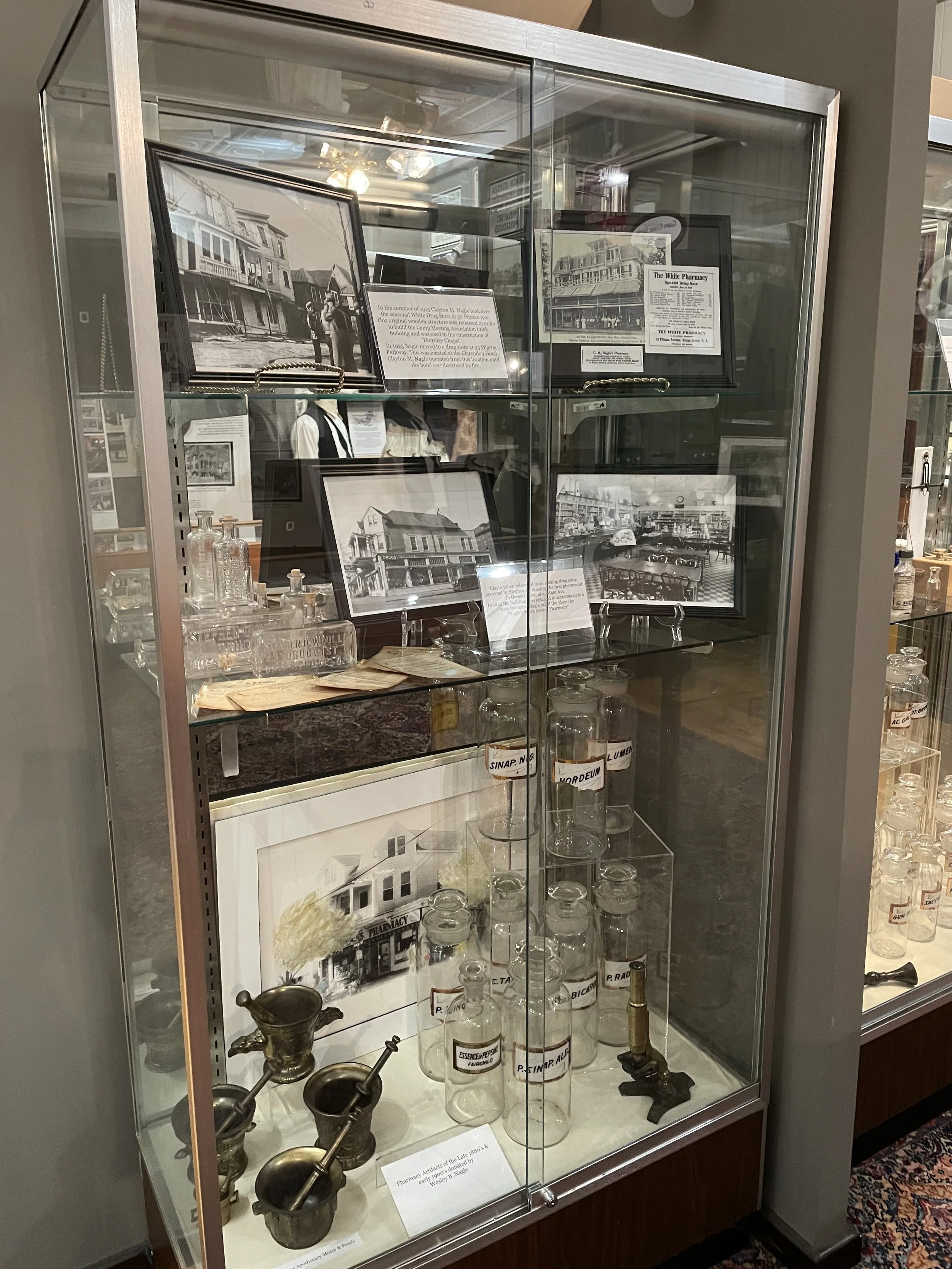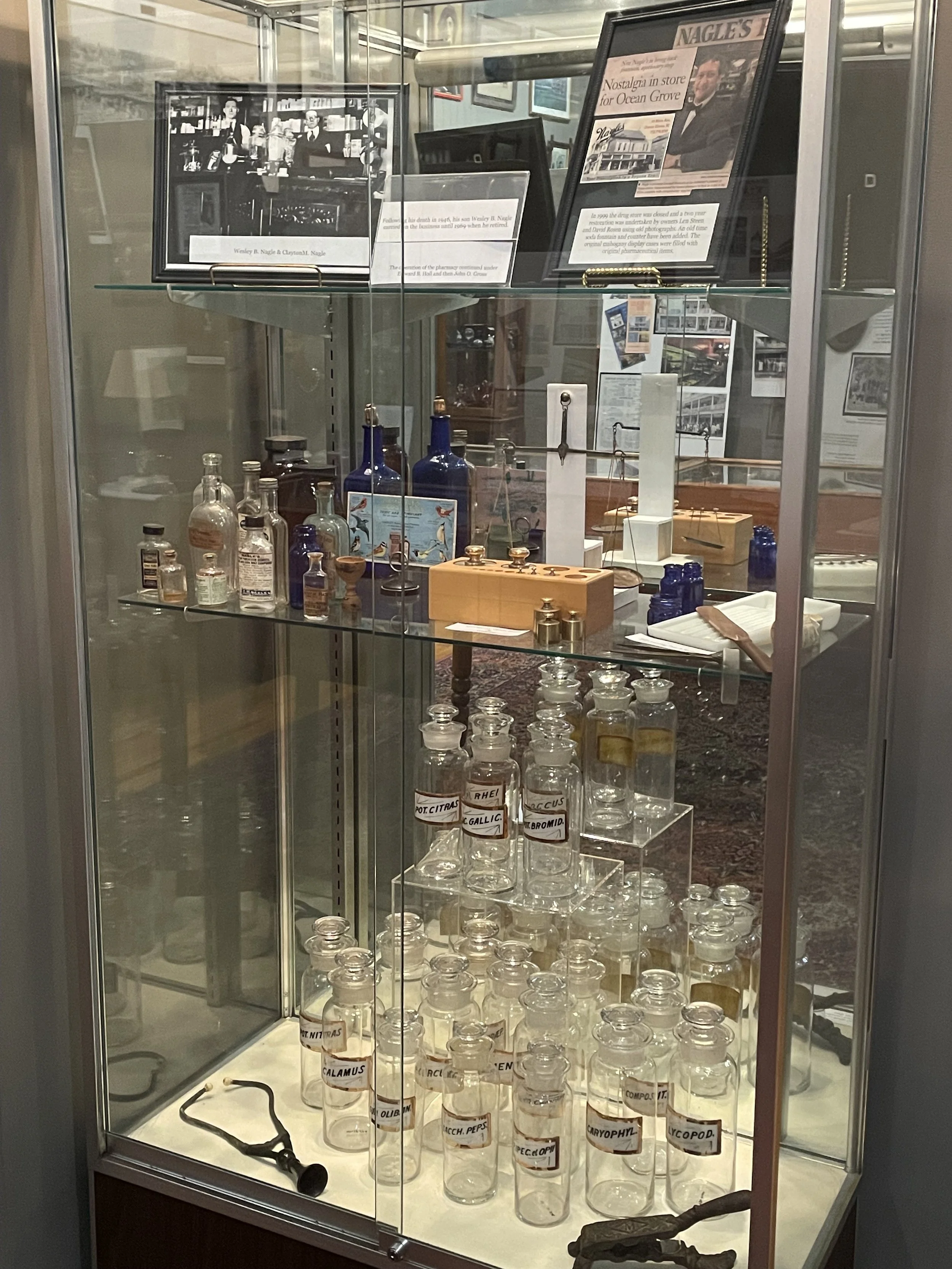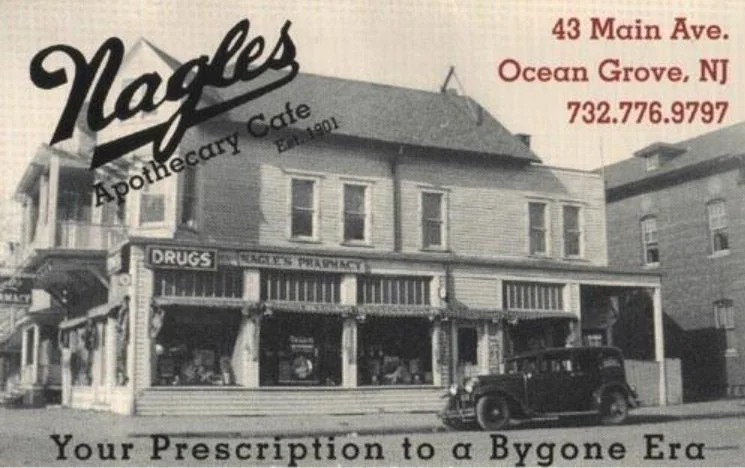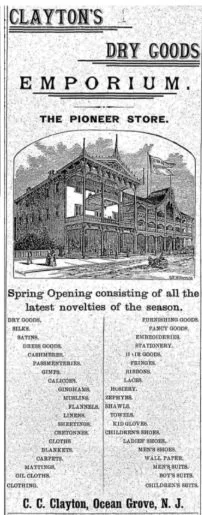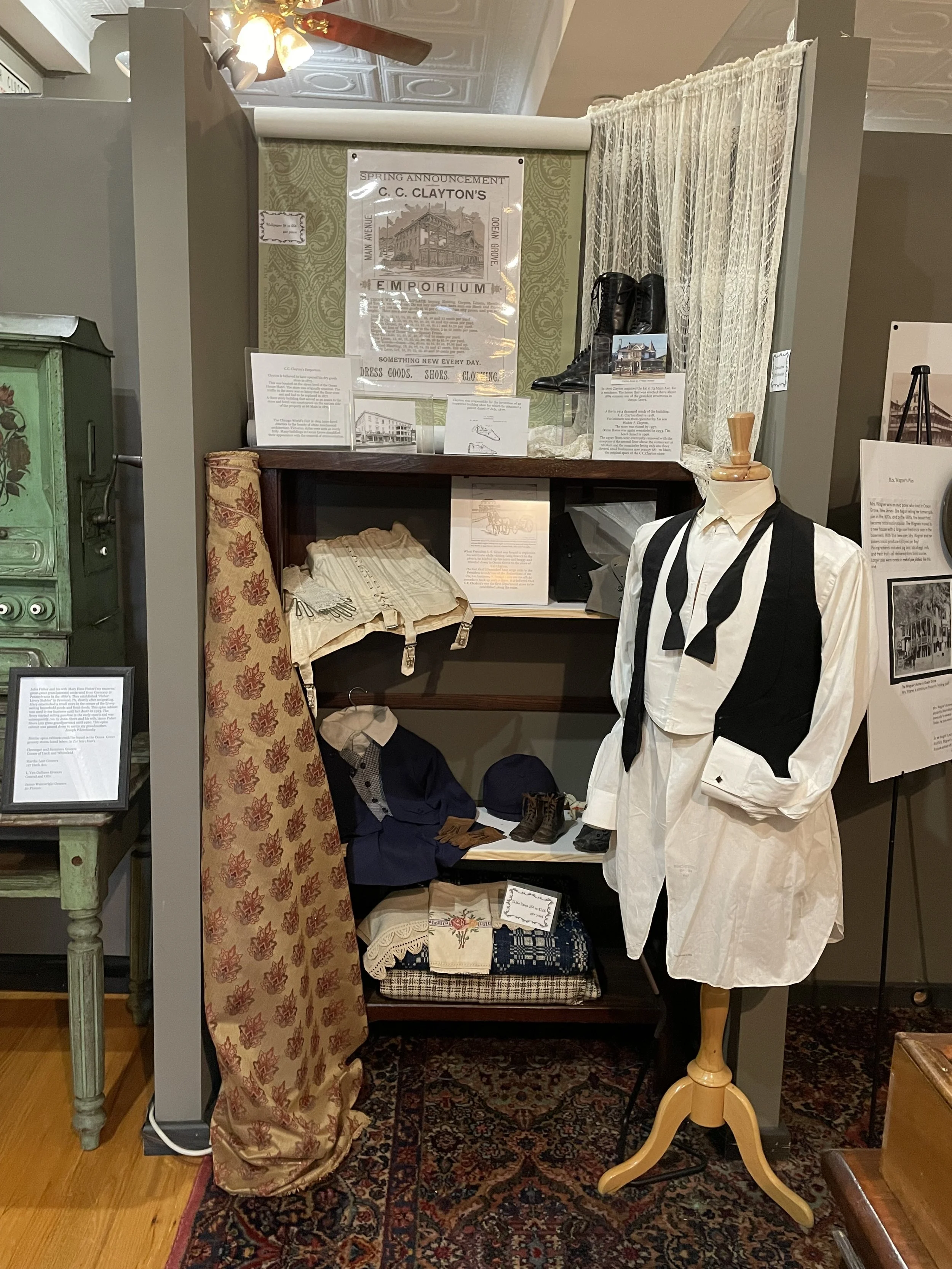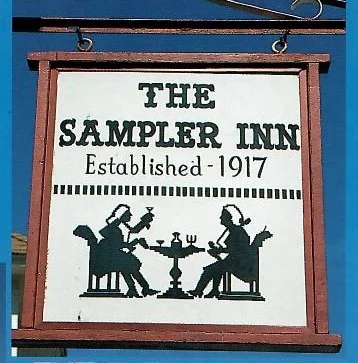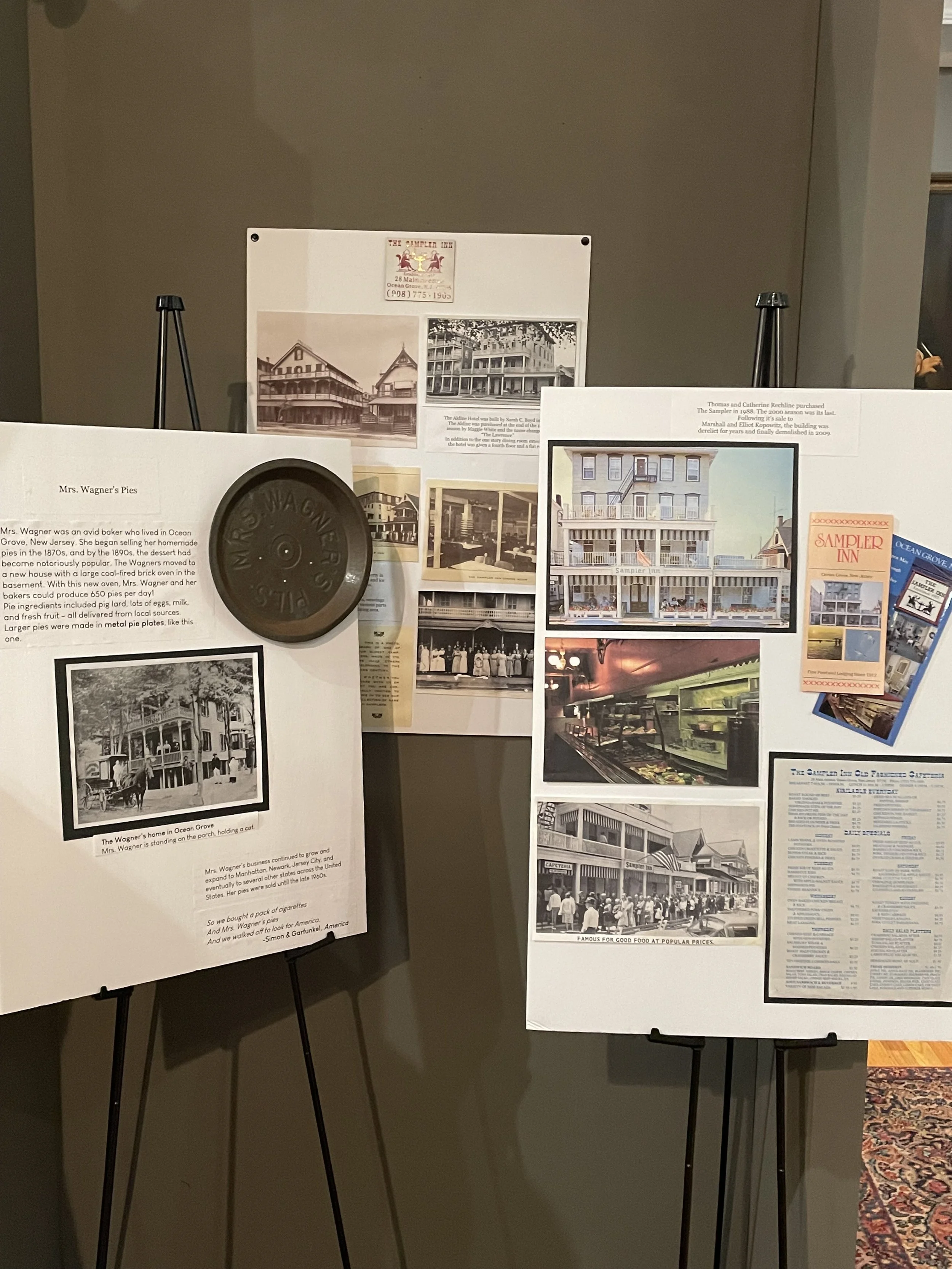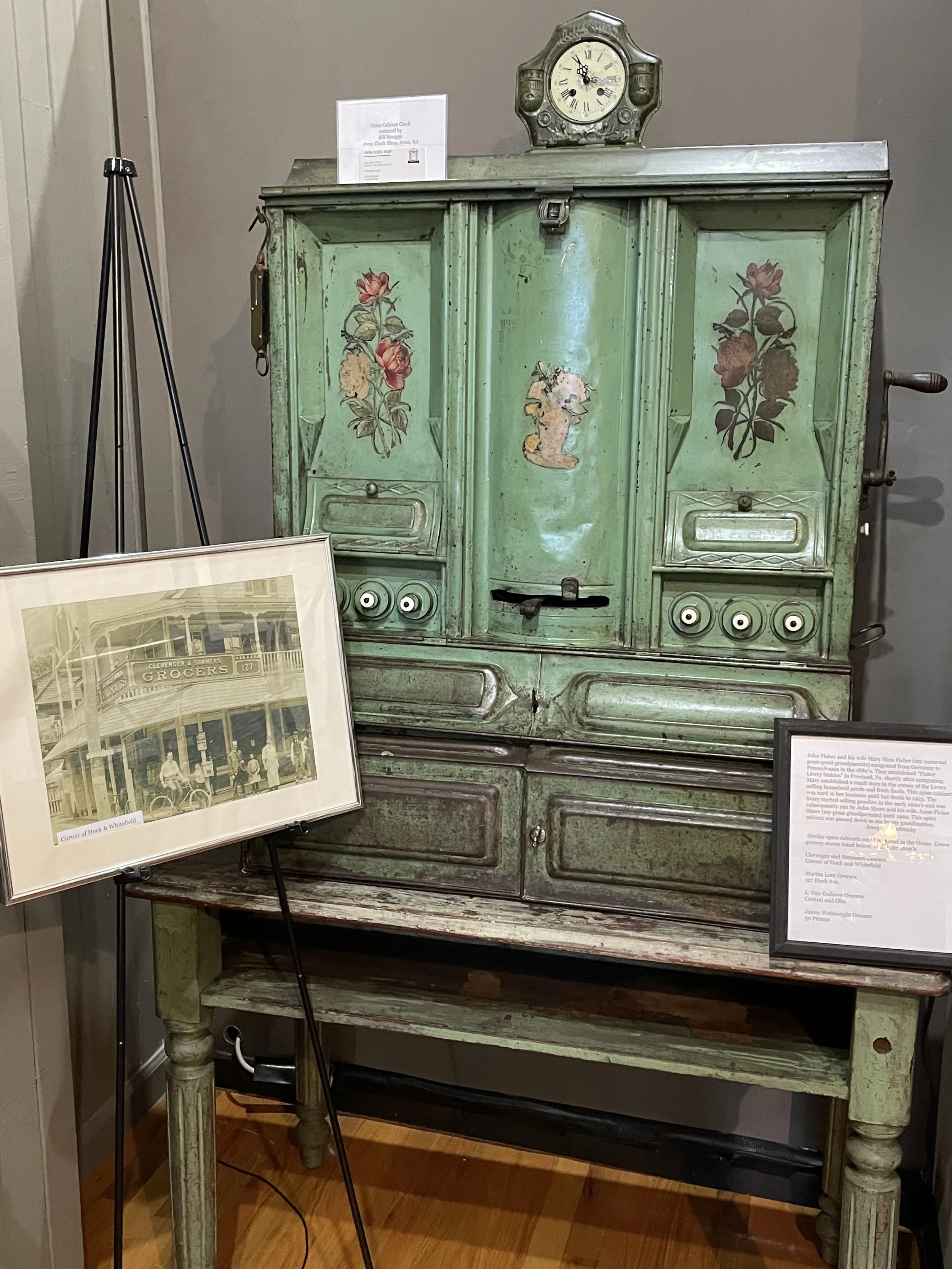
Summer 2023
Businesses that Defined Ocean Grove
Retail History in Ocean Grove
Research by David H. Fox, 2022
Retail stores selling food and household goods were essential. The Association opened the first store near 50 Pitman Avenue, followed by others on Main Avenue, Olin Street, and Pilgrim Pathway. By the mid-1880s, Asbury Park's business district outpaced Ocean Grove’s, drawing much patronage. Ocean Grove retailers rarely advertised, relying on their visible presence, which limits historical records.
-
125 Heck Avenue : This seeming outpost of Ocean Grove retailing was at the northeast corner of Heck and Whitefield avenues. The first owner of numbers 125 and 127 was Charles Rogers, a real estate person and one of the earliest residents of Ocean Grove. It is uncertain if he or the next owner, Joseph Perrine, who had the two structures built.
In 1890, the store at 125 was one story and occupied only a small portion of the lot. By 1905, it had been enlarged to two stories and extended in width and length. Likewise, 127 had a one-story extension in the rear. As Perrine & Jackson, it claimed to be the only year-round food market in Ocean grove in 1893. In 1910, it was the Morton Morris Meat Market.
127 Heck Avenue
This property was likely built by the same party as 125. Clevenger & Summers, grocers were the tenants in 1910.3 It was the home of the Garden State Grocers in 1933.
-
43 Main Avenue, corner of Central Avenue
Originally, this was the site of the Lawrence House that was destroyed in a 1903 fire. 5 A 2½ story drug store was built on the site by 1905. This was occupied by Stephen D. Woolley, the first pharmacist in Ocean Grove. In 1920-1921, the building was enlarged to accommodate a soda fountain. Clayton M. Nagle promptly took over the location when Woolley retired in 1934 as his pharmacy in the Clarendon Hotel had been destroyed in a fire caused by him. Nagle called the new venue “Nagle’s Main-Central Pharmacy.” The business was eventually operated by son Wesley Nagle until his retirement. The pharmacy continued under Edward B. Holl and then John O. Gross.
47 Main Avenue
This appears in the 1890 Sanborn Map as a 1-story drug store. It was apparently the first location of Stephen D. Woolley’s pharmacy, Wooley & Reed, by at least 1889. By 1905, it is shown as 2½ stories. He then moved to 43 Main Avenue into a newly built store c. 1904. By 1936, Morris had turned his attention to other pursuits at this location until 1947. In 1948, Thompson and Gillan, wallpaper hangers and painters occupied the store.11 The building was subsequently used by attorneys and realtors.
49 Main Avenue
John H. Evans opened his “Ladies’ Store” here by 1879.12 It is depicted in 1905 as having 2 stories. The store was operated by Mr. Bendheim in 1914, but there is no mention of the store after 1919. By 1927, it was Cal’s Snack Shoppe which offered meals and a soda fountain.13 By 1960, it had become the E. A. Pace 5 & 10 cent store.14 This was replaced by Bonded TV Service, a radio, TV, and electronics store in 1968.
50-52 Main Avenue
The Morrow, Day & Company complex included the 3-story National Hotel on the west and the 3-story Manhattan Hotel (Morrow Inn) building on the east that had a bakery and ice cream factory in the basement. The National Ice Cream Garden was constructed behind the hotel in 1879. An 1890 Sanborn Insurance Map made after “additions and improvements” shows the “garden” to be an open area 30 by 40 feet surrounded by a structure about 12 feet deep on all sides. A large jet of water is depicted in a view of the garden.
In 1898, a new owner changed the complex to be more profitable. The large ice cream garden in the rear was eliminated for rental cottages. A smaller garden was erected between the eastern and western buildings. The National Hotel building is still standing today as apartments.
After serving as an insurance and real estate office, 50 Main Avenue was used by the Seacoast Electric Company in the 1920s after having been a showroom for the Coast Gas Company in 1913. This opened following the introduction of gas service into Ocean Grove.
In 1931, it was announced that a restaurant would open in the “Manhattan Building”, formerly the Morrow Inn, at 50 Main Avenue.
By 1935, the restaurant had been replaced with the Book and Needle Shop operated by Misses C. M. Beers and E. Courtney.
By 1940, the site had become Gregory’s Caramel and Nut Shop. In the late 1940s, the space was used for a Rexall Drug Store, but then apparently reverted to an insurance office.
51 Main Avenue
A rival to Ocean Grove’s first store at about 50 Pitman Avenue was the 2-story General Store operated by Feree & McKee, first advertised in 1875. In 1879, John M. Dey acquired the business as the “Philadelphia Cash Store” or “Main Avenue Store” selling a great variety of items including sewing machines.
By 1893, the premises was used by James A. Quinn for the sale of sweets.
After two years, the place had become the “Novelty Bazaar” under the management of Miss Lillie Hoagland. By 1897, the Ladies Store had expanded here from 49 Main Avenue. This gave way to Angles & Smith plumbing and sheet iron by 1925. Paint and other hardware items were eventually added to the offerings. Howard Smith became the sole proprietor in the early 1930s and his name remained even in 1971.
53 Main Avenue
This was the Pach Brothers Photographic Building by 1875. It appears with advertising signs in an image of the dedication of the Memoral Vase on the site of the present Post Office.
Tomkins & Son’s establishment here offered a lending library in 1902. By 1910, the place was called the “Ocean Grove Book Store.” Louis E. Bronson had his insurance and real estate office here in 1925. A newspaper store operated by Leon Snider apparently shared the space here in 1928. In 1939, the newspaper store was operated by A. J. Obrecht.
55-59 Main Avenue, Post Office Building
The building housing the Camp meeting Association offices and the Post Office was greatly altered in 1923. The unsafe steeple was removed and one-story commercial space built around the original structure. The early parts were de-Victorianized and all given a Colonial Revial look.
55 Main Avenue
Morse’s Men’s Shop appears to have been the earliest tenant here. In 1930, Leonard’s Woman’s Shoppe opened here selling apparel. By 1939, B. Feddes operated a jewelry store that would continue for decades.
57 Main Avenue
In 1949, B. Feddes, jeweler, of 55 Main Avenue was using this location.
60 Main Avenue
This was the site of a dwelling that was used by W. H. Beegle as a real estate office by the late 1890s. A two-story building with three street level business spaces and apartments above was erected about 1926. The Hamrah Art Shop/Hamrah’s Linen Shop operated here in 1927. In 1929, Paul Chatfield relocated his news and stationary business here from 65 Main Avenue. The Chelsea Groceteria, a food store, operated here in 1933.
65 Main Avenue
Paul Chatfield had his news and stationary business here until 1929 when he relocated to 60 Main Avenue.
68-72 Main Avenue
Likely the largest retail venue in Ocean Grove was a complex of two buildings each consisting of a street level store and a hotel above. The first constructed was at number 72 by about 1873. This was the Hulse and Clayton Store.
In a few years, the business was named the “C. C. Clayton Store.” In 1879, additional space was needed and the second building at number 62 on the east erected. It was connected to the first on the second level by a veranda for the convenience of guests of the Ocean House.
C. C. Clayton is having [1905] the Ocean House on Main Avenue remodeled. Another story will be added, giving sixteen additional rooms. The house will be topped with a square [“flat”] roof. The present cottage front will be torn out and, in its place, will be put a handsome Colonial front with fourteen supporting columns. Mr. Clayton expects to have the alterations finished early in March. In the appearance of the new Ocean House, as it is to be, no trace of the old hotel will remain.
A new kitchen at Ocean House measuring 30 by 30 feet was built of hollow tiles to be fireproof in 1912.
The C. C. Clayton Store seems to have closed shorted after the death of Clayton’s son in 1936. The hotel closed in 1956 and plans announced to remove the upper floors. This involved leaving a second floor above the restaurant at 68 Main Avenue at the eastern end and having the remainder being only one floor. The Shell Craft Hobby Shop was located here by the 1950s. It was notorious for its sidewalk display of a “giant man-eating clam.” Thus, the several businesses from 68 to 72 Main Avenue occupy the original space of the C. C. Clayton Store from the 1870s.
-
43-45 Olin Street, corner of Central Avenue
The 1890 Sanborn Map indicates this as a 3-story retail location for “crockery and china”, while it appears as a “grocery” in the 1905 edition. This was likely the business of Louis vanGilluwe who offered both kinds of items. He gave up the business by 1919. W. Reynolds’ fruit market opened there in 1923. Following the devasting fire at his bedding business in the Brick Building in 1926, Charles F. Kenyon relocated here before returning to his repaired premises in 1927.46 Previously, Andrew J. Hurley may have operated a mattress business at this location. An antique store was likely here in 1928. This building was likely demolished on or before the 1958 construction of the Ocean Grove Motor Inn on the site.
47 Olin Street
This appears as a 2-story structure on the 1890 Sanborn Map. The earliest advertised business was that of a locksmith in 1893.
By 1898, R. M. Furguson had opened a fruit and vegetable market at this location. Fish and oysters were the offerings here by 1910.
The seafood business continued with J. T Wilburt as proprietor in 1925. A new tenant in 1931 was D. C. Stackhouse who sold fruit, eggs, butter, and sausages which he manufactured. Previously, this was a home business on Mt. Hermon Way. This business failed in the Great Depression and an auction held in 1933. It subsequently became Parker’s Fish Market by 1935.
The Ocean Grove Spray Shop, a furniture refinishing business, open here in 1939. No further mention of 47 Olin Street appears in the press. It was likely demolished on or before the 1958 construction of the Ocean Grove Motor Inn on the site.
49 Olin Street
A 2-story addition to Day’s Ice Cream Garden was made on this site by 1889.
The extension of Day Bros.’ ice cream garden rendered other changes to Olin street a necessity, and the readjustment of the barber shop, Mr. Cleaton’s place of business, and Chu Jue’s laundry, give to the whole block much better accommodations, and more harmony of style.
In 1938, Agnes Day (1886-1965), daughter of Pennington Day and owner since 1936, added the tea room for lunches and suppers that were the first meals served at the location. She sold the business in 1950 to Homer K. Secor and wife of Upper Montclair, New Jersey. The business continues in 2023 after changes in ownership.
50-52 Olin Street
In 1893, “Gen.” John C. Patterson designed a 2-story brick building at 50-52 Olin Street for the N. & J. S. Matthews produce market. T. P. Summers and Ocean Grove carpenters did the construction. The building is now a garage for the adjoining fire company.
By 1902, the site had become the Margerum Meat and Provision Company. This was succeeded by McCabe & Margerum, then Margerum & Thomson by 1904. By 1909, it had become Margerum and Gravatt.
By 1918 the James Boyce Meat Market was on the site. In 1933,William B. Gilbert (produce) and Percy Harvey (fish) took over the property for a produce, fish and meat store.
53 Olin Street, the Brick Building
At times this space in the 1889 building extended through the block to Pitman Avenue. James A. Wainright, dry goods, was the first tenant and was located near here prior to the erection of the building. His business was taken over by W. E. Dodge & Company, groceries, by 1897. Wedel’s Variety Store was here in 1901. Subsequent tenants included: Sea Shore Furniture Store (1905), and J. H. Borton, butcher (1922). Charles F. Kenyon had a store for metal beds and mattresses and a mattress factory and his residence on the second floor. This caught fire in 1926 causing much damage. In 1932, W. Meritt’s Meat Market was here and was followed by the J. & M. Coffee Shop in 1961.
55 Olin Street, the Brick Building
George H. Goodheart, meat, seafood, was the original tenant in 1889 and previously occupied a small building on this site. William B. Gilbert, fruits and vegetables, wholesale and retail took over in 1915 followed by Walter C. Parker, fish, clams, oysters, seafood, wholesale and retail. Harry G. Shreve’s meat market here remained open while the rest of the building was burning in 1926.66 In 1937, the This and That Shop, antique jewelry and silver had the space. From 1948, laundries were here.
54 Olin Street
While a house number was not given in advertisements, this was the likely location of the Ocean Grove Fish Market in 1910. The fact that other similar businesses subsequently used the space suggests it had fixtures suitable for this line of retailing. This was the site of Harvey’s Fish Market in 1925 prior to his relocation to 50 Olin Street. The Parker Fish Market moved into this space from 47 Olin by 1938.
56 Olin Street
This was occupied by a fresh food store in 1910.
57 Olin Street
This now empty lot that serves as a parking lot for the 1974 Association Offices was another site of laundry activities with Chu Len by 1909 to 1919.
59 Olin Street
Located at the rear of the Pathway Market, this was the location of laundries at various times. C. S. Jue had the Chinese Laundry there in 1889. The expansion of the Strassburger store eliminated this business space.
-
27 Pilgrim Pathway
A bookstore in a 2-story structure has been located here from the very earliest days of Ocean Grove. This is likely the oldest surviving business in Ocean Grove.
35-37 Pilgrim Pathway, the Clarendon Hotel
In 1894, the Clarendon Hotel was raised creating three business spaces at street level. In 1897, a bakery opened here.
Another business to open was candy factory in 1898.
Fred W. Engel has moved [1915] his drug store in the Clarendon building to the room on the corner of Mr. Tabor Way and Pilgrim Pathway.72
Mr. and Mrs. J. O. Collis have leased and on April 1st [1915] will take possession of the store in the Clarendon building, 35 Pilgrim Pathway, just vacated by Druggist Engel. Mr. and Mrs. Collis formerly conducted a novelty business at 502 Asbury Avenue, Asbury Park, and this will be their line of. trade in Ocean Grove.73
For term of five years, Mrs. Margaret M. Duncan has renewed [1927] her lease of the store at 37 Pilgrim Pathway, in the Clarendon building, for the sale of orange juice.74
In 1923, pharmacist Clayton M. Nagle (1871-1946) moved to the corner drug store in the Clarendon at 35 Pilgrim Pathway.75 The reason for the move might be that no mention is made of a soda fountain at Nagle’s earlier location at 52 Pitman Avenue other than take-out ice cream. More elaborate offerings at the Engel location included candy, Breyers’ ice cream, sodas, and hot chocolate and coffee with whipped cream. Nagle operated his location all year and was the first soda fountain to do so.
Unfortunately, Mr. Nagel would end up destroying the Clarendon Hotel on 5 December 1934. About 11:20 p. m. Nagel had been preparing an ointment in the back room when it caught fire. He sustained burns attempting to extinguish it, but being unable to do so, quickly alerted the fire department. The blaze brought out firemen from surrounding communities. At about 2:30 a. m., the front wall of the building collapsed nearly hitting some fire fighters on the second-floor porch. The fire was not brought under control until around 3 a. m.76
38 Pilgrim Pathway, corner Pitman Avenue
Johnson Taylor of Freehold, New Jersey, operated a 2½-story bakery on the corner of Pitman
Avenue and Pilgrim Pathway, site of the present-day Association Offices, by 1875.77 In October 1900, the business was reported bankrupt.78
In 1902, part of the property was taken over by Mrs. Wiliam Wagner for use as a store and bakery.79 Previously, she had a home business that grew to the point that she moved to 124-126 Mt. Tabor Way that had a commercial oven in the basement. The business prospered and eventually expanded to New York City, Brooklyn, and Newark. Production in Ocean Grove ceased with World War I, but products were brought in from Newark, New Jersey, facility.
40 Pilgrim Pathway
A former 2-story dwelling on Pilgrim Pathway next to the bakery was used as a novelty store in 1885.80 In 1889, it was used by Prof. R. A. Tusting as a branch of his piano and organ business of Asbury Park.81 The location is currently the Community Room of the Association Office Building.
42 Pilgrim Pathway, northeast corner Olin Street
The Monmouth County Dairy Products Company conducted business here until 1909 when the site was taken over by E. H. Boon.82 He continued the sale of dairy products along with vegetable, fruits, and cooked meats.
By 1913 A. L. E. Strassburger (1872-1933) operated a grocery store at this location.83 He was involved with the operation of several hotels in Ocean Grove. He also had a grocery location at 50 Pitman Avenue. He found it necessary to enlarge the Pilgrim Pathway store in 1913.84 This work included the taking of the other business spaces in the building and increasing the whole to three stories with the stucco exterior we see today. Paul J. Strassburger (1879-1955), apparently a brother, took over the business by the mid-1920s when A. L. E. turned to operating an insurance office. The store was sometimes leased out during the winter season to various operators.
In 1946, Strassburger decided to sell the business, probably due to his retirement.85 Herbert A. Philson and Thomas Davis were the new owners and renamed the place the “Pathway Market.” Davis’s son-in-law, Herbert Brown acquired the business in 1964.86 He continued until at least 1994.
47 Pilgrim Pathway
Pilgrim Pathway near Olin Street
A jeweler was here by 1885.88 By 1889, novelties were offered as well.
-
48 Pitman Avenue
This was originally the site of a large sand dune that ran through the middle of Ocean Grove. Following its removal, Day’s Ice Cream occupied the area in 1876. This seasonal establishment was owned by confectioner brothers Wilbur Fisk (1838-1913) of Morristown, New Jersey, and Pennington Mulford Day (1847-1928) of Newark, New Jersey. In 1904, the frilly Victorian ornamentation gave way to the popular Colonial Revival Style.
Mr. Day will expend about $3,000 in these improvements. The plans were supplied by Cottrell of Asbury Park. It is expected the work will be completed by the first of the year. Through Mr. Day’s enterprise, there will thus be added a handsome and substantial improvement to Pitman Avenue.90
50 Pitman Avenue
The earliest store in Ocean Grove was located near 50 Pitman Avenue in 1870. It was apparently poorly situated and blocked the sidewalk.
A number of buildings have been erected by the Association, for business and other purposes. Among these are a store for general merchandise and provision, also, a building used by the Association for post office, telegraph office, general news office, book store, etc.91
Another work of necessity was the enlargement of the storehouse [“store”], which has been occupied for two years past by Jemison Brothers, at a cost of about $1,300. It may be matter worthy of consideration in this connection, whether there is yet sufficient accommodations in the store line, for our growing population. If it should be thought advisable to multiply or increase these accommodations, there are those whom we might approve, who are ready and anxious to engage in business.92
The store owned by the Association, and occupied by Mr. Jemison, overruns the sidewalk about six feet, is in the way. Mars the symmetry, and is a very great annoyance to persons passing up and down that thoroughfare. I recommend its removal back at least six feet, and an addition of 25 feet to its eastern (?) end.93
This store appears in a c. 1879 print showing (l. to r.) the Arlington House, Day’s Ice Cream, the Association Store, and the James A. Griffing & Company Drug Store.
On 1 January 1879, the store was leased to James A. Wainright and Elisha A. Errickson. They also ran a store in in Squan Village, New Jersey, by 1878 and Asbury Park at Main Street and Railroad Avenue by 1885. The partnership was reported dissolved in the Asbury Park Journal of 14 December 1889. An advertisement placed in the Ocean Grove Record of 7 August 1886 describes the offerings.
A major change to this establishment took place in 1889 with the construction of the “Brick Building.”
For several years, the old frame building in which Wainwright and Errickson transacted business, as also several smaller ones immediately surrounding it, demanded attention in the way of extenstive repairs, or removal, and new ones placed in their stead. The latter was thought to be the better course. The old store was therefore completely torn down, and the smaller ones removed to other locations.
The large three-story brick building, 44 x 105 feet on the ground and 33 feet high, was erected on the lots thus vacated, at a cost , everything complete, of $11,657,95.
The extension of Day Bros.’ ice cream garden rendered other changes to Olin street a necessity, and the readjustment of the barber shop, Mr. Cleaton’s place of business, and Chu Jue’s laundry, give to the whole block much better accommodations, and more harmony of style.94
The site in question was occupied by four wooden structures. George H. Goodheart’s meat market was in a small building near 55 Olin Street that he appears to have occupied from 1879. He also had a business at 291 Washington Market in the New York City meatpacking district. Behind this near 52 Pitman Avenue was a drugstore run by James A. Griffings, then A. Alison White, who was originally from Philadelphia, and died on November 20, 1899, at age 41. Between these two was a small rear structure of unknown purpose, possibly the restroom described as being on the “business block.” The major building, on the eastern half of the site, was that leased by James A. Wainright and Elisha A. Errickson.
50 Pitman Avenue, the Brick Building
James A. Wainright, dry goods, groceries, was the first tenant in this location. He was succeeded by W. E. Dodge & Company, groceries, by 1897. Wedel’s Variety Store was here by 1901. It then served as a grocery under Clevenger & Summers in 1903, A. L. E. Strassburger by 1914. The Atlantic and Pacific Tea Company was here during the 1926 fire and continued until least 1934.
52 Pitman Avenue, Street Level of the Brick Building
A pharmacy was here from 1889 to 1923 as Alison White, 1913, White’s Pharmacy, C. F. Kennedy, proprietor in 1913, White’s Pharmacy, and C. M. Nagel, proprietor, in 1915. A Chinese laundry occupied the space in 1925
Nagles
Clayton M. Nagle, Pharmacist
By David H. Fox, 2020 (abridged)
Clayton M. Nagle was born in Pottstown, Pennsylvania, in 1871 and graduated from the Philadelphia College of Pharmacy in 1894. He worked in pharmacies in New York City and Perth Amboy, NJ, before opening Nagle’s Pharmacy in Plainfield, NJ, around 1901, which operated until 1920.
In 1915, Nagle took over the seasonal White Drug Store in Ocean Grove, NJ, originally established by A. Alison White. He operated it only during summers, maintaining the tradition of prior owners.
In 1923, Nagle moved to a year-round pharmacy at 35 Pilgrim Pathway, located in the Clarendon Hotel. His offerings included sodas, candy, and ice cream. After a fire destroyed the hotel in 1934, Nagle relocated to 43 Main Avenue, taking over from retiring pharmacist Stephen D. Woolley. He renamed it Nagle’s Main-Central Pharmacy.
Nagle was active in the Ocean Grove community, serving as Fire Commissioner for 25 years, and participating in several fraternal, civic, and religious organizations.
He died in 1946 at age 75, survived by his wife, Bertha, and son Wesley B. Nagle, who continued the pharmacy. Wesley, also a pharmacist and civic leader, retired in 1969 and died in 1990.
The pharmacy later passed to Edward B. Holl and John O. Gross. In 1999, it was renovated and reopened in 2000 as “Nagle’s Apothecary Café,” combining a restaurant and ice cream shop, continuing the legacy of the Nagle name in Ocean Grove.
Day’s
Listen to the full feature here:
Days has been in Ocean Grove well over one hundred years, founded by Wilbur and Pennington Day in August 1876. When the Day brothers came to Ocean Grove from Morristown to open their ice cream parlor, the building was the only structure between it and the ocean. The original business included an outdoor ice cream garden which is still retained. In 1903 it was enlarged to its present style.
In 1878, the Day brothers established a second ice cream parlor in Asbury Park, but that was discontinued in 1929.
The original business sold ice cream and candy, but in 1938, Miss Agnes Day, daughter of the original owner, Pennington Day, added the tea room for lunches and suppers.
Day’s ice cream has been well-known for years by every day folk as well as the rich and famous. The ice cream was a favorite of F.W. Woolworth as well as Gov. Edward Stokes, and Schumann-Heink. Pugilists (boxers) such as Max Baer and James Corbett were also customers of Days. Corbett came on many occasions when he trained here.
William Hersey who made millions from from his manufacture of chocolate candy made his first batch with Wilbur Day at the Morristown branch of Days in 1928. That first batch was actually blended on a tombstone.
Days still exists today as a restaurant and ice cream garden and is known as the Starving Artist at Days. Its two young owners Dave Fernicola and Arnold Teixeria have kept the traditions of Days alive. Now, more than one hundred years later Days are till famous for its ice cream.
CC Clayton’s
An excerpt from the full article by David H. Fox, 2020
Conover Cornelius Clayton, who sometimes called himself “Conover” and other times “Cornelius,” was born on 31 December 1841. He was the son of James Clayton and Alice Ann Conover of Marlboro near Freehold, New Jersey. By 1860, Clayton was living with William and Eliza Cooper of Freehold. In 1870, he was living in Freehold with Ralph and Margaret Hulse. A woman of the same name as his future wife also lived in this household.
Clayton is believed to have opened his dry goods store in 1873. This was located on the street level of the Ocean House hotel, 70-72 Main Avenue. He apparently owned the structure and leased the hotel to various owners for the summer season. The store was originally seasonal as well.8 The traffic in the store was so heavy that the floor wore out and had to be replaced in 1877. A three-story building that served as an annex to the store and hotel was constructed on the eastern side of the property at 68 Main Avenue in 1879. His installation of bluestone flagging in front of the store attracted favorable comment in the newspaper in 1883.
The C. C. Clayton Store sold a great variety of items including matting, carpets, oil cloths, clothing and shoes for men, women, and children, fabric, sewing needs, bedsheets, curtains and wallpaper. In 1893, it was claimed the stock represented $40,000.12 The store also served as a local stop for the J. Buckelew Business Messenger Service that carried papers and small packages to Cortland Street, Manhattan, from Ocean Grove and Asbury Park.
Cornelius C. Clayton invented a bathing shoe in 1877, patented as No. 193,077, designed with a canvas upper and a cork sole. The shoe was lightweight, durable, and quick-drying, offering protection from rough surfaces like pebbles. It featured eyelets for secure lacing, preventing sand from entering, and was easily produced. Clayton supplied these shoes to coastal businesses, making them a popular choice for beachgoers.
The Sampler Inn
An excerpt from the full article by David H. Fox, 2020
The Sampler Inn, originally established as the Sampler Shop Cafeteria by Mary Newberry Wright in Ocean Grove, New Jersey, began as a novel self-serve dining concept and became the town’s first and only cafeteria. Despite an incorrect address in early announcements, it quickly gained popularity due to its wholesome, affordable food and unique décor featuring handsewn samplers. Mary Wright, a former educator and dean, successfully ran the business until her death in 1937, after which the inn passed through several owners. Though it thrived for decades—particularly under the Pappayliou family—it ultimately followed the decline of the local hotel industry. After years of neglect, failed condo redevelopment plans, and bankruptcy under the Koplitz brothers, the once-iconic building fell into disrepair and was demolished by Neptune Township in 2009.
Mrs Wagner’s Pies
Mrs. Wagner was an avid baker who lived in Ocean Grove, New Jersey. She began selling pies in the 1870s, and by the 1890s, the dessert had become notoriously popular. The Wagners moved to a new house with a large coal-fired brick oven in the basement. With this new oven, Mrs. Wagner and her bakers could produce 650 pies per day! Pie ingredients included pig lard, lots of eggs, milk and fresh fruit- all delivered from local sources. Larger pies were made in metal pie plates like the one above. Mrs. Wagner’s business continued to grow and expand to Manhattan, Newark, Jersey City, and eventually to several states across the United States. Her pies were sold until the late 1960s. For example, check out this link to the Wisconsin Historical Society’s record of their own Mrs Wagner’s pie truck or a reference to her pies in the song “America” by First Aid Kit.
Grocers in Ocean Grove
Before 1950, Ocean Grove was home to a number of grocers and food markets scattered across several streets, serving the needs of both year-round and seasonal residents. The earliest known grocer was Wainright & Errickson at 50 Pitman Avenue, later succeeded by W.E. Dodge & Company, and eventually by the Atlantic & Pacific Tea Company. On Heck Avenue, Perrine & Jackson claimed to operate the only year-round food market in 1893, and 127 Heck housed the Garden State Grocers in 1933. On Olin Street, Louis vanGilluwe offered both groceries and crockery at 43–45 Olin, while 50–52 Olin was home to a succession of meat and produce markets including Margerum & Gravatt and later Gilbert & Harvey. At 47 Olin, the location evolved from a fruit and vegetable market to Parker’s Fish Market by the 1930s. The Strassburger grocery store at 42 Pilgrim Pathway was a prominent operation beginning in 1913 and continued as the Pathway Market under new owners until the 1990s. Additionally, the Chelsea Groceteria operated at 60 Main Avenue in 1933. Together, these establishments formed a robust and evolving network of grocery and food retail options in Ocean Grove’s early commercial landscape.

